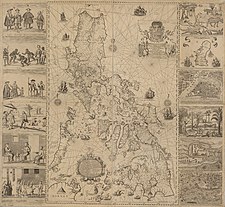1991 eruption of Mount Pinatubo
Eruptive activity began on April 2 as a series of phreatic explosions from a fissure that opened on the north side of Mount Pinatubo.
Beginning June 6, a swarm of progressively shallower earthquakes accompanied by inflationary tilt on the upper east flank of the mountain, culminated in the extrusion of a small lava dome.
When even more highly gas-charged magma reached Pinatubo's surface on June 15, the volcano exploded, sending an ash cloud 40 km (25 mi) into the atmosphere.
Huge pyroclastic flows roared down the flanks of Pinatubo, filling once-deep valleys with fresh volcanic deposits as much as 200 m (660 ft) thick.
The eruption removed so much magma and rock from beneath the volcano that the summit collapsed to form a small caldera 2.5 km (1.6 mi) across.
Damage to bridges, irrigation-canal systems, roads, cropland, and urban areas occurred in the wake of each significant rainfall.
It also followed the Philippine Fault System west as far as Baguio, which was devastated, and is located about 80 km (50 mi) north-northeast of Pinatubo, leading volcanologists to speculate that it might ultimately have triggered the 1991 eruption, although this is impossible to prove conclusively.
Two weeks after the earthquake, local residents reported steam coming from the volcano, but scientists who visited there in response found only small rockslides rather than any pre-eruptive activity.
Radiocarbon dating of charcoal found in old volcanic deposits revealed the last three major explosive eruption periods in recent millennia, about 5500, 3500 and 500 years ago.
In early June, tiltmeter measurements had shown that the volcano was gradually inflating, evidently due to fast-growing amounts of magma filling the reservoir beneath the summit.
Given all the signs that a very large eruption was imminent, the Philippine Institute of Volcanology and Seismology – assisted by the United States Geological Survey – worked to convince local inhabitants of the high severity of the threat.
On the same day, Typhoon Yunya, locally named Diding, struck the island, with its center passing about 75 km (47 mi) north of the volcano.
The volcanic column from the crater covered an area of some 125,000 km2 (48,000 sq mi), bringing total darkness to much of Central Luzon for 36 hours.
Tephra fell over most of the South China Sea and ash falls were recorded as far away as Vietnam, Cambodia, Singapore, Malaysia and Indonesia.
A reported 847 people were killed by the eruption, mostly by roofs collapsing under a load of accumulated volcanic matter, a hazard amplified by the simultaneous arrival of Typhoon Yunya.
After the eruption, about 500,000 people continue to live within 40 km (25 mi) of the volcano, with population centers including the 150,000 in Angeles City and 30,000 at Clark Freeport Zone.
Many farmers near Pinatubo began growing quick-ripening crops such as peanuts, cassava, and sweet potatoes, which could be harvested before the threat of lahar floods during the late summer rainy season.
In total, 42 percent of the cropland around the volcano was affected by more lahar floods, dealing a severe blow to the agricultural economy in the region.
[21] Since the eruption, each heavy rain has brought massive lahars from the volcano, displacing thousands of people and inflicting extensive damage to buildings and infrastructure costing billions to repair.
On September 3, 1995, a lahar buried San Guillermo Parish Church in Bacolor, Pampanga to half its 12 metres (39 ft) height.
[21] The United States Air Force initiated a massive airlift effort to evacuate American service members and their families from the two affected bases during and immediately following the eruption, named Operation Fiery Vigil.
This very large stratospheric injection resulted in a volcanic winter, a reduction in the normal amount of sunlight reaching the Earth's surface by roughly 10% (see figure).
[31] At the same time, the temperature in the stratosphere rose to several degrees higher than normal, due to the absorption of radiation by the aerosol.
After the areas surrounding the volcano were declared safe, many Aetas returned to their old villages only to find them destroyed by pyroclastic and lahar deposits.
Moreover, to hasten the implementation of the basic services for the afflicted, private sectors, including the NGOs, took part in offering relief.
The Asian Disaster Reduction Center focuses mainly on the following forms of aid:[35] After the eruption, many of the homes were destroyed and many of the areas affected by lahar were deemed uninhabitable.
Faced with the destruction of many of the farmlands and the displacement of farmers and other workers the government had to search for a long-term solution to address the issue.
The region's roads, bridges, public buildings, facilities, communication, and structures for river and flood control were some of the great concerns of the government.
This event showed the need to engage in scientific studies to reassess the current policies and knowledge on areas with risk of eruption.
[36] Among the countries that extended humanitarian relief assistance were Australia, Belgium, Canada, China, Denmark, Finland, France, Germany, India, Indonesia, Italy, Japan, Malaysia, Malta, Myanmar, the Netherlands, New Zealand, Norway, Saudi Arabia, Singapore, South Korea, Spain, Sweden, Thailand, the United Kingdom, and the United States.











